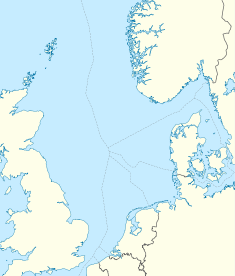- Magnus oilfield
-
Magnus oilfield Location of Magnus oilfield Country United Kingdom Region North Sea Offshore/onshore Offshore Coordinates 61°32′N 1°35′E / 61.533°N 1.583°ECoordinates: 61°32′N 1°35′E / 61.533°N 1.583°E Operator(s) BP Partners BP
Marubeni
Nippon
EniField history Discovery 1974 Start of production 1983 Abandonment 2015 Production Current production of oil 30,000 barrels per day (~1.5×106 t/a) Current production of gas 100 million cubic feet per day (2.8×106 m3/d) Estimated oil in place 1,540 million barrels (~2.10×108 t) The Magnus oilfield is a large oilfield in the United Kingdom's zone of North Sea. It is located 160 kilometres (99 mi) north-east of the Shetland Islands. The field is located mainly in Block 211/12a. Resources are estimated to total 1.54 billion barrels (245×106 m3) of oil, of which 869 million barrels (138.2×106 m3) are recoverable reserves.[1]
Contents
History
The Magnus oilfield was discovered in March 1974 by BP. The discovery was made 2,709 metres (8,888 ft) below the seabed in the younger sands of the Late Jurassic by the semi-submersible drilling rig Sedco 703. Similarly to several other fields in the area, the field was named after the Viking saint–Magnus of Orkney.
Fabrication of the Magnus structure began in 1980 at Highland Fabricators' yard at Nigg Bay in the Cromarty Firth. The jacket of the Magnus platform, the main oil export pipeline to the Ninian Central Platform, and the Northern Leg Gas Pipeline to Brent A were installed by 1982. In May 1996, the production started at the South Magnus field.[1] First oil from the field was achieved in August 1983.
The enhanced oil recovery project was proposed in 2000.[2] It was implemented in 2003.[3]
Reserves
Magnus field's reserves are estimated to contain 1.54 billion barrels (245×106 m3) of oil, of which 869 million barrels (138.2×106 m3) are recoverable reserves.[1]
Technical description
The field is developed by a single central combined drilling and production platform. The Magnus jacket is the largest single piece steel structure in the North Sea. It was designed, manufactured and installed by John Brown Offshore. The original system also included seven subsea producing wells which were later turned around to water injection duty.
The produced oil is transported by a 91-kilometre (57 mi) long 24-inch (610 mm) pipeline to the Ninian Central platform, and further to the Sullom Voe Terminal. Produced natural gas from Magnus, together with gas from the Thistle and Murchison fields, is transported by a 79-kilometre (49 mi) long 20-inch (510 mm) pipeline to Brent A and further through the FLAGS to St Fergus in Aberdeenshire.[1]
Enhanced oil recovery project
To increase the recoverable oil from the field and to extend the field life, an enhanced oil recovery (EOR) project was implemented. The EOR project involved importing gas from the two West of Shetland fields Foinaven and Schiehallion to the Sullom Voe terminal where liquefied petroleum gas is added to natural gas. This gas stream is then transported by another pipeline to the Magnus platform where it is reinjected into the Magnus reservoir to aid pressure support and increased oil recovery. It is expected to increase the recoverable oil reserves by 50 million barrels (7.9×106 m3) and extend the field life to beyond 2015.[4][2] The project cost around £320 million.[4]
References
- ^ a b c d "The Magnus field" (PDF). BP. http://www.bp.com/liveassets/bp_internet/globalbp/STAGING/global_assets/downloads/U/uk_asset_magnus.pdf. Retrieved 2009-12-01.
- ^ a b "BP unveils £2.75bn investment plan". BBC News. 2000-09-08. http://news.bbc.co.uk/2/hi/uk_news/scotland/914514.stm. Retrieved 2009-12-01.
- ^ "Pipeline boost for oilfield". Edinburgh Evening News. 2003-03-14. http://business.scotsman.com/business/Pipeline-boost-for-oilfield.2410273.jp. Retrieved 2009-12-01.
- ^ a b "Magnus EOR, Shetlands, United Kingdom". offshore-technology.com. Net Resources International. http://www.offshore-technology.com/projects/magnus/. Retrieved 2009-12-01.
Categories:- BP
- Oil and gas industry of Shetland
- Oil fields of Scotland
Wikimedia Foundation. 2010.

